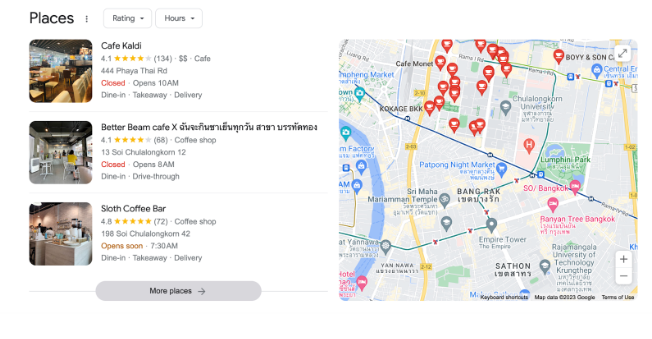There’s an awful lot of SEO statistics out there, with tons of numbers and facts that may leave you feeling lost and puzzled.
So, we’ve taken the time to sift through and carefully handpick some truly eye-opening SEO statistics for 2023 that directly relate to your business!
We’ve broken it down for you and included some insights into what each statistic can mean for you. This way, you can make smarter decisions that can drive your business further.
Table of Contents:
- What are SEO statistics?
- How important are SEO statistics in decision making?
- Top SEO Statistics that matter for your business
What are SEO statistics?
Before anything else, what are the SEO statistics?
SEO statistics are numbers and data that reflect trends, patterns, and metrics related to how websites rank in search engine results.
They answer questions like, “Does long-form content work better than short-form?”, “Is SEO in mobile and desktop the same?”, “Is SEO even worth it?”, and so many more.
Furthermore, they give you an idea of user and consumer behaviours, and many other aspects of SEO that can help you see where improvements can be made, so you can improve your website’s online visibility and attract more customers.
How important are SEO statistics in decision making?
Really important!
These proven numbers give you a glimpse of what might succeed or not. They provide you with a solid foundation to kickstart your SEO journey.
Or, if you’re already on the path, they guide your strategy in the right direction.
Of course, while these numbers are valuable, they’re not set in stone. Every situation is unique. So, each statistic should be examined closely to see if it fits your scenario and goals.
Top SEO Statistics that matter for your business
1. General SEO Statistics
Is SEO actually worth it? Here are the numbers to kickstart everything.
- “To buy or not to buy?” 53% of shoppers do research with a search engine to figure out if a product is worth it or not.
Buyers rely a lot on search engines to find out about things they plan to purchase – checking out reviews, looking at pictures or videos of the product, comparing prices to save money, or even getting to know your company’s values.
Sometimes, they might even have questions and want to connect with you before buying.
What this means for you: First off, get your product details right on your website. Second, and this is the key, get your website set up for SEO. This way, it climbs higher in search results, and people can easily find what you’re offering.
- Marketers claim SEO (organic search) yields the highest ROI among leading digital marketing channels.
In a poll by Search Engine Journal on Twitter, most people (49%) picked organic search as the top ROI for their website. Paid search, social media, and email follow, with 19%, 18%, and 14% respectively.
What this means for you: We’re not saying you ditch the rest of the marketing opportunities. But hey, many businesses are already reaping the rewards of organic search, so there’s no reason why you shouldn’t give it a shot too!
- Google remains the number one search engine in the world!
In fact, it’s WAY ahead of other popular search engines, grabbing around 86% of the market compared to Bing and Yahoo’s 8% and 2%, respectively. This means that people worldwide tend to use Google more when searching online.
What this means for you: Focus on optimizing your website and content specifically for Google’s search algorithms. This way, you’ll have a better chance of getting people to visit your website.
2. Ranking Statistics
Does ranking on page 1 of Google’s results actually make a difference? Here are a few important stats to back that up.
- The first three organic Google search results capture over 50% of all clicks.
The very first result grabs a huge 27.6%, almost twice as much as the second position, which gets 15.8%. The third one gets 11%.
For positions 4 to 9 (or sometimes 10), they divide up the remaining clicks, with the share getting smaller as you go down the list.
What this means for you: Only aiming for the first page isn’t enough. You want to go for those top 3 spots in the organic search results. Why? Because that’s where the clicks are flowing, giving your business a better shot at success.
- Only 0.63% of people click past the first page.
This means a lot of people don’t even think about checking pages, 2, 3, 4 and beyond unless what they’re looking for isn’t on page 1.
Surprisingly enough, there are some who might not even realize there’s a page 2! Unless they scroll all the way down, there are no hints at all.
What this means for you: If you can’t land in the top 3 spots, at least aim for the last one. Ranking last on the first page is still way better than getting lost on page 2.
- Paid results (PPC) get fewer clicks despite ranking higher than organic results.
The very first ad in search results only gets a 2.1% click-through rate (CTR), while the first organic search result scores a 39.8% CTR.
Perhaps, it’s because people don’t like stuff being forced on them when they’re being sold to. Regardless, those numbers show that people just prefer and trust organic results over paid ones.
This is not to say that PPC is a bad deal. In fact, seasoned marketers will tell you that the “right” blend of PPC and SEO gives you even better outcomes than choosing one alone.
What this means for you: Give more attention to organic results because people tend to view you as more reliable and reputable. Plus, SEO is gentle on your budget compared to PPC – perfect if you’re starting out or working with a tight wallet.
- 19% of searches feature a rank “zero” that tops all other search results
We’re talking about featured snippets! And they look like this:
As you can see, it’s right up there at the top of the search results, making it easy for users to click and access the website.
Even though a study from Ahrefs says featured snippets might not always get clicks, just owning this spot proves that your site is important and helpful, which really gives your reputation a nice boost.
What this means for you: Optimize your content to rank for featured snippets. This helps people know more about your brand and think that you’re the best at what you do.
- “Old” websites rule the first page of Google search results.
In fact, about 60% of the websites on the first page are three years old or older. Those around two years make up less than 20%, and around 22%, are just one year old.
Google acts like people do in this case. We usually trust businesses that have been around for a while – it’s just how things work.
What this means for you: No matter if your website has been around forever or just kicked off, you can’t control time – it keeps ticking on. So, use this to your advantage. Keep your site updated, craft valuable content, and be truly helpful to your visitors.
- Even if your site is in the top 3 search results, there’s still a 49% chance your visitors might leave your website in a snap!
And that’s concerning because 49% is nearly half of the people you worked so hard to bring to your site! This tells us that the “bounce rate” bug can affect any website, no matter its position in the search rankings.
Furthermore, this SEO stat highlights how important engagement is! You must be able to keep them interested and hooked throughout their browsing journey on your website.
What this means for you: Get to actually know your audience inside out! What keeps them interested? What information are they really looking for? Doing this helps you craft better web copy or content that they’ll love and enjoy.
3. Keyword Statistics
When it comes to SEO, it’s pretty clear that keyword research is a must-do, though it might seem a bit daunting. Hopefully, the stats below can help you make smarter choices in your keyword research plan, making it all less overwhelming and totally rewarding.
- About 92% of the searches people make are long-tail keywords.
To put it differently, if someone wants info on SEO they won’t just type “SEO.” They might go for something like “best seo tools for beginners” or “top seo companies in Australia.”
This tells us that searchers often have a clear goal and search intent, and are looking for something specific, whether it’s making a purchase or simply gaining information.
So, it’s no surprise that longer keywords tend to get nearly double the clicks compared to one-word searches.
What this means for you: Incorporate relevant long tail keywords in your website copy, and craft high-quality content, such as blogs and articles, that addresses the needs and questions of your target audience using these long-tail keywords.
- Featured snippets are usually 40 – 50 words
Remember rank “zero” from earlier…
As per SemRush, they are roughly 250 – 300 characters short. But, it’s not always a strict rule, and it can vary in certain situations.
The point is, Google’s primary aim is to provide the best and quickest answer to what people are asking about. These featured snippets focus on keywords that start with questions like “why”, “how”, “when”, “where”, and so on.
The more you can hit the mark in just a few sentences or words, the higher your chances of getting featured.
What this means for you: Skip the fluff and get straight to the point! You must regularly produce content that directly addresses your customers’ questions and queries.
- 15% of Google searches are completely brand new.
Yup, never been looked up before, ever!
Why does it matter? Well, if you dig deeper, you’ll realize this is a chance to claim your space early and be the pioneer in discussing something completely new!
And since no one else has started the conversation, there would hardly be any competition. This means you can focus on fine-tuning your content with that keyword and soar to the top of search results.
What this means for you: Keyword research is more than just using those fancy tools. Figure out where your target audience hangs out and keep tabs on what they talk about. You might be amazed by the trends you discover!
4. Local SEO Statistics
If you run a brick-and-mortar store, the following stats will shed light on how local SEO can be a game-changer for your business.
- Around 30% of mobile searches are for finding nearby businesses, services, or places.
Furthermore:
- 60% results in customers directly calling the business
- 76% leads to people visiting the actual store within a day, with 28% of these visits ending in a purchase
Of course, we’d hope for the sales percentages to be higher. However, the reality is that 80% of shoppers use their mobile phones inside physical shops to check reviews, compare prices, and find alternative stores (Outerbox).
So, if you see your in-store customers huddled in a corner with their phones, you can pretty much guess what’s up.
What this means for you: Make sure your website functions well on mobile devices. Apart from that, focus on using local keywords in your articles and blogs, and make sure your Google My Business (GMB) profile is complete and accurate.
- Around 42% of those who perform local searches click on the Google Map Pack.
Also called the Google 3-pack, the local map pack is a section that features three local businesses, along with their pinned locations on a map.

Because it’s often positioned at the top of search results, it’s super easy to spot (and quite eye-catching) for users.
So, it’s not surprising that nearly half of them click on these listings to find useful business details, just like you can see in the picture above.
And with “near me” searches having gone way up over the years, it’s only natural to think that click-through rates for local map pack listings will also go up significantly.
What this means for you: Optimize your Google My Business (GMB) Profile, making sure that your business information liked address, opening hours, and contact information are correct and up-to-date.
- 87% of searchers trusts Google to evaluate local businesses…
Much higher than other platforms such as Yelp, Facebook, and Trip Advisor, which have trust percentages of 48%, 46%, and 29%, respectively.
This emphasizes how important it is to have a complete and updated GMB profile. In fact, Google says customers are about 3 times more likely to see your business reputable if they find a complete Business Profile on Google Search.
When you have loads of great reviews, Google believes in you more. That means you’re more likely to appear high up in the map pack and gain trust from potential customers, making them choose you.
What this means for you: Your customers truly value Google reviews. So, use tactics that motivate customers to share their thoughts and provide feedback, and make sure to promptly and genuinely respond.
5. Mobile Statistics
If you believe that getting your desktop site in perfect shape guarantees the same on mobile, think again! Check out the Mobile SEO numbers below to understand why it’s not that simple.
- Over half of all web traffic worldwide comes from mobile devices.
To break it down further, 55.7% of this traffic comes from mobile phones, while desktop and tablets contribute 42.37% and 1.94%, respectively.
And here’s another interesting thing: A good 63% of the overall mobile traffic comes from people searching organically on search engines, according to Statista.
So, it’s no surprise that Google has since shifted its focus to put mobile first. And with around a third of the world expected to be using only mobile devices soon (according to WARC), this move totally makes sense.
What this means for you: Make sure your website works smoothly on mobile and loads seamlessly, without any hiccups. If not, you might find it a bit of a challenge to climb up the ranks in search results.
- 53% of visitors immediately leave a website that takes more than three seconds to load.
In fact, results from one of Google’s polls show that waiting for web pages to load is the biggest source of frustration for 46% of respondents when they’re browsing the internet on their mobile devices.
What this means for you: Regularly check and optimize your website’s loading speed, aiming to keep it between 3 to 5 seconds.
- Just 17% of websites managed to hold onto their rankings on both mobile and desktop search results.
This tells us that mobile and desktop platforms are completely separate playing fields, and excelling in one doesn’t guarantee success in the other.
Of course, there are multiple factors at play here, one being the way users behave on desktop compared to mobile.
So, it only makes sense that Google adjusts its algorithm to align with these behaviours and make the user experience better on each platform.
What this means for you: Prioritize your website’s responsiveness and page speed. Apart from that, adopt a mobile-friendly approach in terms of your content.
- On a typical mobile screen, about half of it is taken up by a featured snippet
This means that users often notice and interact with a snippet right away!
They might even skip scrolling and directly engage with the snippet instead of clicking on other links further down.
Unlike searching on a desktop, the snippet takes up only a tiny part of the screen, which gives users the chance to check out other choices and explore further.
What this means for you: Make the most of users being drawn to mobile featured snippets. Aim for mobile-specific keywords and questions-based queries (like “why,” “how,” “when,” etc.) as these often lead to snippets showing up.
6. Backlink Statistics
Backlinks are one of the top three key factors that influence your SERPs rankings. Below are some important backlink-related statistics.
- The top 1 page in SERPs receives an extra 5%–14% of new dofollow backlinks every month.
Claiming the top spot isn’t just about visibility.
Sure, the first-ranked page gets the most eyes, but it also signals to users, “Hey, this page is probably trustworthy.”
So, when users spot your website at the number one spot, they often link back to it from their own sites, reinforcing your top position. This is what Ahrefs calls the vicious circle of SEO.
What this means for you: Outranking the top 1 website requires putting in extra effort. Keep in mind that the top-ranked site’s backlinks tend to increase rapidly, so make sure your strategy can outpace their growth.
- Making long-form content results in around 77.2% more backlinks on average.
The reason is simple: unlike short content, longer articles can hold a lot more valuable information and details, and users can find everything they need in one place without having to jump around different sources.
This approach is favoured by Google as well, making long-form content preferable over shorter, incomplete pieces.
But how long is “long” when it comes to content? Backlinko suggests that your content should stretch to at least 3000 words if you want to gather a good number of backlinks.
What this means for you: Craft a content strategy that integrates longer pieces like blogs and articles. Don’t forget, nailing down the “right” keywords and topics is key – that’s how you’ll uncover what your audience is interested in.
- Roughly 66.5% of the backlinks created over the past nine years are no longer active.
The backlinks on your website today won’t last forever.
A few of the websites currently linking to your site might close down, remove pages, or update their content in the future. And that’s why those links may become obsolete over time.
With that said, it is essential to continually build new, high-quality backlinks to backlink profile strong and healthy.
What this means for you: Have a solid backlink management strategy in place. Regularly monitor the quality and relevance of your backlinks, and remove or replace any broken ones.
7. Voice Search Statistics
Voice searches are becoming extremely popular because they let you do things much faster. Aside from playing music, setting an alarm, or calling a friend, one can ask for directions, find nearby shops or products, and quickly get answers to your questions.
Here are stats to help you dive into the world of voice search.
- 52% of drivers use voice search while they’re on the road.
If you’re low on fuel and need to find a nearby gas station, or if you’re in a rush for a quick meal, or even if a passenger has a medical emergency, voice search proves to be quite useful.
This is why this SEO stat about drivers using voice search on the road makes perfect sense.
Generally, around 61% of people, find voice search particularly useful when their hands are busy or when they’re focused on something else and can’t look at the screen.
What this means for you: Make sure to include voice search tactics in your local SEO strategy to make it easier for your potential customers looking for your offerings in the vicinity to find you.
- Nearly 41% of all voice search responses come from a featured snippet.
And that makes sense because, as we’ve mentioned earlier, featured snippets offer fast and direct-to-the-point answers to users’ questions.
So, when you focus on optimizing for featured snippets, you’re not just reaching Rank 0 with greater visibility, but you’re also boosting your chances of being picked for voice search results.
But keep in mind that there are a few things to keep in view. Voice search questions often lean towards being longer and more conversational compared to text searches.
Additionally, the typical voice search result is quite brief, around 29 words, which is even more concise than featured snippet answers.
What this means for you: Similar to aiming for featured snippets, focus on question-based queries when creating your content.
Pay attention to shaping your page’s title, headings, and frequently asked questions (FAQs). This will make your content more voice-search-friendly.
- The stronger your domain and backlink authority, the more Google will select your page as the voice search result.
This one is a no-brainer!
Of course, when your domain and backlink authority are strong, it’s a clear sign that your website is credible and knowledgeable in your industry. This credibility serves as a trust indicator, making it more likely for your content to rank in voice search results.
What this means for you: Your hard work to enhance your desktop and mobile rankings isn’t in vain. In fact, these improvements actually overlap and positively impact your voice search success. It’s hitting two birds with one stone!
8. Video Statistics
Video content has become increasingly popular, especially on social media platforms. But do they actually contribute to your search engine rankings? Take a look at the video SEO stats below to see their impact.
- Content that includes videos gets more backlinks and enjoys a whopping 157% increase in search traffic.
Videos have been a pretty big hit on social media platforms. So, it’s no wonder that many prefer watching videos over reading text-based content.
And so, it also shouldn’t come as a shock that you’ll score more backlinks and increased traffic!
When you combine text and video, you make both readers and video enthusiasts happy. It’s like a win-win situation, as you’re catering to a wider audience with different content preferences.
Here’s the scoop from Backlinko to guide you on what kind of video to include on your page:
- Around 68.2% of YouTube video results are in high definition (HD).
- On average, YouTube videos that make it to the first page are about 14 minutes and 50 seconds long.
What this means for you: If you haven’t started yet, include videos in your content, and enjoy increased engagement from your audience!
- Users are more likely to be interested in and engage with videos that align with their passions and interests.
In an interesting study by Google on video-watching habits, 12,000 participants ranked their top three reasons for watching videos as follows:
- 1 – learning something new
- 2 – digging deeper into my interests
- 3 – connecting with my passions
So, the focus is more on what users personally value than factors like the video’s quality or the brand of the platform they’re using.
What this means for you: This statistic should encourage you to enhance your “how-to” blogs and info articles by including videos that directly address their needs and questions, adding more value to your audience’s experience.
A helping hand can go a looong way!
So, there you have it: 27 powerful SEO statistics at your disposal. Make the most out of this information in your own ways.
But if you still have a bunch of questions in mind…
Remember that you can always team up with a reliable SEO professional. They know these stats like the back of their hand, and have a deep understanding of the story behind them – so they won’t just throw SEO numbers around without proper context.
Having spent years in the world of SEO, we had a great time gathering all this data and realizing how the landscape has greatly evolved over time. If you’re curious about how these stats can work for your business, don’t hesitate to reach out to our SEO expert today!






